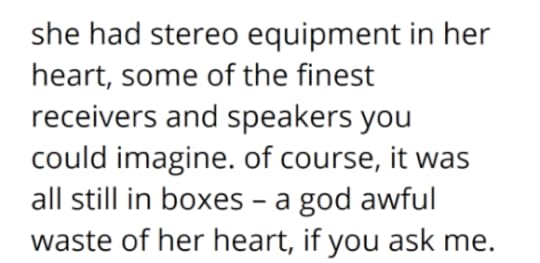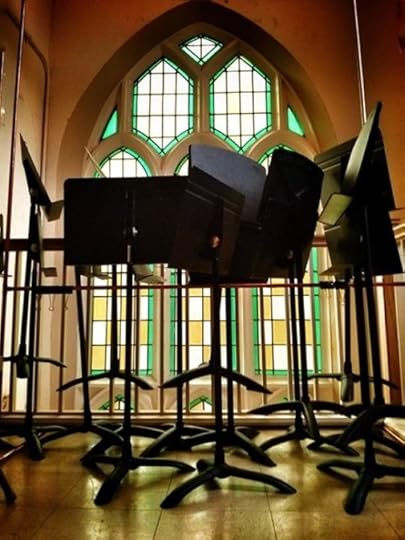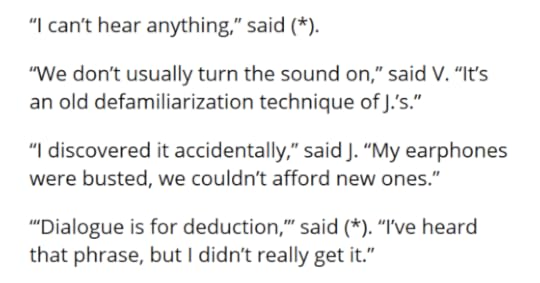Marc Weidenbaum's Blog, page 241
April 18, 2020
Buddha Machine Variations No. 5
On the weekend, the home office is just home. After four days of combining various Buddha Machines, I thought, “Why not run one through the modular synthesizer?” Someone on Instagram had mentioned pairing it with Morphagene, a module which I have (it’s the central, colorful one on the top row), but I decided to send the first-generation Buddha Machine loop through Clouds (a Clouds variant, Smog, fourth in from the right on the bottom row). Aspects of the live sample are being varied in Smog based on some fairly level and quite slow LFOs (the Batumi through the SPO, where those short orange cables are visible toward the upper left). Only two spectral bands of the Smog-processed audio are being heard; they’re coming through the FXDf. And an unmolested version of the Buddha Machine loop is also heard, quietly in what for much of the track is the background. And yes, I do, definitely, need to sort out a better way to capture the audio for these videos (I’m just doing it on my phone currently).
This Week in Sound: Stationary v. Non-Stationary Noise +
These sound-studies highlights of the week are lightly adapted from the April 13, 2020, issue of the free Disquiet.com weekly email newsletter This Week in Sound (tinyletter.com/disquiet).
As always, if you find sonic news of interest, please share it with me, and (except with the most widespread of news items) I’ll credit you should I mention it here.
▰ Fascinating explanation from Robert Aichner, of Microsoft Teams, on how they’re using AI to increase noise cancellation, and the difference between “stationary” (“such as a computer fan or air conditioner running in the background”) and “non-stationary” noise, in this interview by Emil Protalinski. “Going forward, Microsoft Teams will suppress non-stationary noises like a dog barking or somebody shutting a door. ‘That is not stationary,’ Aichner explained. ‘You cannot estimate that in speech pauses. What machine learning now allows you to do is to create this big training set, with a lot of representative noises.'” (Via subtopes)
▰ “It starts with a single neighbor clapping. Soon dozens more join in, throwing open their front doors or hanging from their windows to put their hands together,” writes Amanda Hess of New York City’s answer to Italy’s singing, praising quarantine applause. “Clappers may have learned of the ritual through a Facebook post or a message chalked on the pavement of a neighborhood park. But it persists because we hear it, and we want to keep hearing it. Some days it is the only thing I hear from outside that is not an ambulance siren.”
▰ If a largely forgotten voice AI is shut down, who misses its unique sonic qualities? “Back in 2012, Samsung introduced its S Voice assistant as it sought to keep up after Apple went all-in on Siri,” writes Richard Lawler. “Samsung acquired Viv to use its tech for a replacement, Bixby. Bixby hasn’t made that much of a mark either, but now Samsung is pulling the plug on S Voice. … S Voice service will end as of June 1.”
▰ “Without the broad-spectrum filters of trains and traffic hum, every layer of that soundscape can be heard clearly once more,” writes Tim Rutherford-Johnson. “As with the air, particulates and pollution are dropping away. Sound and breath both arrive in higher fidelity. This week, British seismologists have noticed that the ‘cultural noise’ of the earth has started to quieten too.””
https://johnsonsrambler.wordpress.com...
▰ A health app that listens to and reports back on your cough? I checked that the date on this piece said April 10, not April 1, and it turns out to be true. Read up as JC Torres explains what the Coughvid app does: “The team is using AI to distinguish between different kinds of coughs the same way doctors listen to your cough. The idea is to help reduce the number of people going to doctors demanding for a test when they don’t exhibit the symptoms.”
▰ “NLS [the National Library Service for the Blind and Print Disabled] holds more than 25,000 braille transcriptions of musical scores and instructional texts; large-print scores, librettos, reference works and biographies; instructional recordings in music theory, appreciation and performance; and music-related talking books and magazines,” writes Mark Hartsell. “NLS also commissions 40 to 50 transcriptions each year — last year, it produced a braille version of the massively popular musical Hamilton.'” (Via Mike Rhode)
▰ Find music you can’t help but dance to like Dieter Rams dances to Oscar Peterson in Gary Hustwit’s documentary Rams (with music, as well, by Brian Eno). (As mentioned here last week, it streamed for free through April 14 at ohyouprettythings.com/free.)
▰ ▰ ▰ ▰ ▰ ▰ ▰ ▰ ▰ ▰ ▰ ▰ ▰ ▰ ▰
PROJECTION MAPPING
I spend a lot of time on YouTube. It’s one of the main places I listen to music, especially the thriving culture of live electronic music performances. As a result, I can’t help but track certain visual techniques, tropes, and stylistic touches, things like houseplants, and commonly employed angles, and nature shoots, and the careful deployment of color and cute objects.
I sure hope the projection technique employed in this video by German musician Perplex On catches on. Note the lights on the small controller in front of the iPad, as well as on the musician’s fingers. You have to check it out: youtu.be.
▰ ▰ ▰ ▰ ▰ ▰ ▰ ▰ ▰ ▰ ▰ ▰ ▰ ▰ ▰
GRACE NOTES
▰ I’ve gotten really into, of all things, The Great Pottery Throw Down series on TV, and have been pondering the purposefully cracked glaze of Japanese “raku” ware as an early glitch-aesthetic progenitor.
▰ April 7, 2020: So, I decided to talk a walk. It was so beautifully clear and sunny outside it’s absurd, in contrast with what’s happening in general right now. I looked at my phone to turn on an audiobook, and the news was there. One of my heroes is gone. Hal Willner is dead. I used to tweet each morning every musician (and related) I saw on Wikipedia’s death reports and in obituary pages, and it got to be too much. These days, it would really be too much. Since Hal Willner died, pretty much all I’ve been doing on guitar (I started taking lessons a couple years ago) is trying to learn “Little Rootie Tootie” by Thelonious Monk. I mean “learn,” but, you know, it’s been pretty satisfying.
April 17, 2020
Friday Office Ambience
Friday office ambience. Six of FM3’s Buddha Machines, from left to right: indeterminate color gen2, light blue gen1, clear gen 3 (aka Chan Fang), dark blue gen 4 (the edition for Philip Glass’ 80th birthday), white gen5, and green gen1. At a reader’s suggestion, I let this one run on for over two minutes.
I may do another with the Gristleism box (FM3 + Throbbing Gristle) added on Monday, though a low-pass filter is probably required to have it settle in with the other members of the robot choir.
April 16, 2020
Disquiet Junto Project 0433: Kit Bits

Each Thursday in the Disquiet Junto group, a new compositional challenge is set before the group’s members, who then have just over four days to upload a track in response to the assignment. Membership in the Junto is open: just join and participate. (A SoundCloud account is helpful but not required.) There’s no pressure to do every project. It’s weekly so that you know it’s there, every Thursday through Monday, when you have the time.
Deadline: This project’s deadline is Monday, April 20, 2020, at 11:59pm (that is, just before midnight) wherever you are. It was posted on Thursday, April 16, 2020.
These are the instructions that went out to the group’s email list (at tinyletter.com/disquiet-junto):
Disquiet Junto Project 0433: Kit Bits
The Assignment: Create a kit’s worth of percussion samples.
Thanks to folks on the Disquiet Junto Slack for helping to plan this.
Step 1: As with the past four weeks, this week’s project is intended to encourage and reward collaboration. Keep that in mind. The work you do this week will be used by someone else next week.
Step 2: The project is to create a kit’s worth of samples. Define “kit” as you wish, and come up with as few or as many samples as you wish. The samples should all be forms of percussion (again, defined as you wish). Between 5 and 10 sounds about right, but there are no limits.
Step 3: Upload the samples for sharing, and make sure they’re downloadable. Consider labeling each with some identifying characteristic. If you do this on SoundCloud, please create a playlist of the samples and include disquiet0433 in the title of the playlist. (Note: While you be making multiple sounds, please upload just one kit’s worth of samples.)
Seven More Important Steps When Your Sample Kit Is Done:
Step 1: Include “disquiet0433” (no spaces or quotation marks) in the name of your tracks.
Step 2: If your audio-hosting platform allows for tags, be sure to also include the project tag “disquiet0433” (no spaces or quotation marks). If you’re posting on SoundCloud in particular, this is essential to subsequent location of tracks for the creation of a project playlist.
Step 3: Upload your tracks. It is helpful but not essential that you use SoundCloud to host your tracks.
Step 4: Post your tracks in the following discussion thread at llllllll.co:
https://llllllll.co/t/disquiet-junto-project-0433-kit-bits/
Step 5: Annotate your tracks with a brief explanation of your approach and process.
Step 6: If posting on social media, please consider using the hashtag #disquietjunto so fellow participants are more likely to locate your communication.
Step 7: Then listen to and comment on tracks uploaded by your fellow Disquiet Junto participants.
Additional Details:
Deadline: This project’s deadline is Monday, April 20, 2020, at 11:59pm (that is, just before midnight) wherever you are. It was posted on Thursday, April 16, 2020.
Length: The length and number of samples is up to you. Brief is probably best, and between 5 and 10 is probably best.
Title/Tag: When posting your tracks, please include “disquiet0433” in the title of the tracks, and where applicable (on SoundCloud, for example) as a tag.
Upload: When participating in this project, be sure to include a description of your process in planning, composing, and recording it. This description is an essential element of the communicative process inherent in the Disquiet Junto. Photos, video, and lists of equipment are always appreciated.
Download: Given the nature of this particular project sequence, it is best to set your track as downloadable and allowing for attributed remixing (i.e., a Creative Commons license permitting non-commercial sharing with attribution, allowing for derivatives).
For context, when posting the track online, please be sure to include this following information:
More on this 433rd weekly Disquiet Junto project, Disquiet Junto Project 0433: Kit Bits — The Assignment: Create a kit’s worth of percussion samples — at:
More on the Disquiet Junto at:
Subscribe to project announcements here:
http://tinyletter.com/disquiet-junto/
Project discussion takes place on llllllll.co:
https://llllllll.co/t/disquiet-junto-project-0433-kit-bits/
There’s also a Disquiet Junto Slack. Send your email address to twitter.com/disquiet for Slack inclusion.
Image associated with this track is by Abby, used thanks to a Creative Commons license and Flickr. The image has been cropped, colors shifted, and text added.
Thursday Office Ambience
Five out-of-sync Buddha Machines by FM3. The green and (light) blue are the first generation. The indeterminate color is the second generation. The clear one is third generation (also known as Chan Fang). The dark blue one is a collaboration between FM3 and Philip Glass (choral voices in this loop).
Video at youtube.com/disquiet.
April 15, 2020
Putting TikTok to Unintended Use
In this sweet little video demonstration, Shawn James Seymour (half of the husband-wife duo Lullatone, along with Yoshimi Yomida) shows how he used the TikTok video social-media app — in particular it’s feature-not-a-bug looping mode — to make a simple ambient track out of piano loops. He set all the loops, four total, to different lengths, and then let them play out on repeat, so that the notes overlap in different combinations. This “criss-cross” is, as he notes in one of a sequence of cards he displays by hand during the video (those hands colliding elegantly with the ones visible in all four of the devices laid out across the table), along the lines of how Brian Eno composed Music for Airports.
Last year, the influential and crafty artist Christian Marclay teamed with Snapchat, another social-media network, for an exhibit that mined user data to create all manner of sound art projects (see: latimes.com). The scale and scope of what Seymour is up to is, of course, quite more modest in comparison, but it also uses the app itself to achieve its goals. As Seymour says (well, displays on a card), inspirationally, in the video: “twisting technology to make something new is usually more fun than just browsing on it.”
This is the latest video I’ve added to my YouTube playlist of recommended fine live performances of ambient music. Video originally posted at the Lullatone YouTube channel. More from Lullatone at lullatone.com.
Wednesday Office Ambience
Four thankfully out-of-sync Buddha Machines. Green and blue are the first generation, the indeterminate color is second generation, and the clear one is third generation (also known as the Chan Fang model).
I just noticed the Gristleism box (a collaboration between Buddha Machine creators FM3 and the band Throbbing Gristle) staring down from the shelf on the right.
April 14, 2020
Live Coding “Avril 14th”
It’s April 14, which is just another day on the calendar, unless you’re an Aphex Twin fan. If you’re an Aphex Twin fan, then today is like your other favorite holiday, and your birthday, and an idealized version of Record Store Day all wrapped up in one. It’s the day when musicians celebrate the Aphex Twin song that takes its name from this date, “Avril 14th” (off the 2001 album Drukqs), and do their thing to and with it. Today there were numerous versions, as always, but the one that stole my heart was this live-coding version by Lil Data, who committed it in the open-source language TidalCycles. Screenshot above. Click through to Lil Data’s Instagram or Twitter accounts to witness it in all its monospace beauty as Lil Data brings the song to life one typed character at a time. “Avril 14th” is a solo piano piece, and it’s always a pleasure to watch the attention performers pay to it, such as Josh Cohen, whose YouTube video has racked up well over 300,000 views since it debuted in January 2017, and Kelly Moran (a Warp labelmate of Aphex Twin’s), who posted a version Twitter today. But watching as Lil Data trades a piano keyboard for a computer one is next level. And in the opens-source spirit of the software, Lil Data posted the code-cum-transcription on GitHub. More on TidalCycles at tidalcycles.org. In the days leading up to April/Avril 14, Aphex Twin rebooted his soundcloud.com/user18081971 account (the seemingly generic name is, in fact, his birthday, August 18, 1971) and began posting new music, including a beautiful ambient piece, “qu1”:
Major thanks to twitter.com/rbxbex for having hipped me to Lil Data.
April 13, 2020
A Modern Decameron
The great hilobrow.com website is in the midst of virtual Decameron. Writing in her introduction to this currently unfolding series, Peggy Nelson breaks down the origin of the term and the borrowed concept: “In Boccaccio’s original Decameron (circa 1353), ten friends decamped for a large mansion outside of Florence for two weeks to wait out the black plague surging through their city, and whiled away the time (when not indulging in light agriculture, or heavy prayer) by telling each other stories.”
Following Boccaccio’s lead, Nelson is rolling out a post a day for ten days by people creating something in isolation. This Hilobrow Decameron, which goes by the name Ten Days, isn’t just stories and poems, but photographs, and weird avatars, and of course, sound. In fact, all seven — as of today — entries have some manner of sonic content, Saturday’s in particular:
Day 1, a short essay by Vince Keenan, included this keen observation about a role of eavesdropping in daily life, and about the void left when chance has been severely, even when purposefully, limited:

Day 2 delivered a magically surrealist story by Scotto Moore titled “Teeth,” which included this bit:

Day 3, a collection of photos by Puzzlepurse included this ecclesiastical assemblage:

Day 4, sound by and above and beyond the shore were touched upon in Vijay Balakrishnan’s poetry:

Day 5, the clincher, is a set of carefully selected and artfully treated field recordings, if not gold well still then something, by Jimmy Kipple:
Day 6, Russell Bennetts and Colin Raff produced avatars that match our strange times, including this one with its “gradient grasp-rasps”:

Day 7, today, Monday, April 13, is a piece of fiction by Josh Glenn, the founder of Hilobrow, which includes this dialog regarding a piece of unspooling footage:

There are three more days after today, the last of which is something I wrote. Something, oddly, that has limited sonic content.
Follow the advent-calendar-like unfolding of Ten Days at hilobrow.com.




